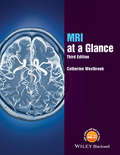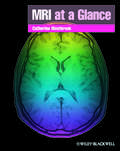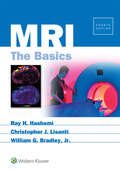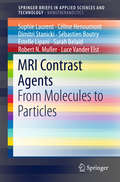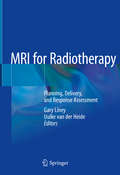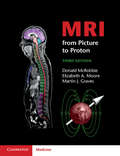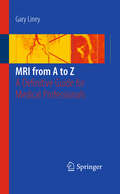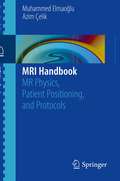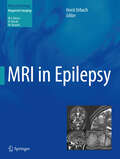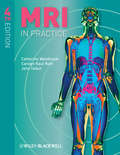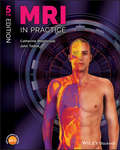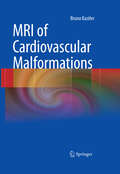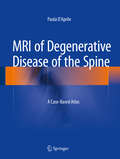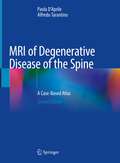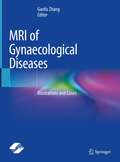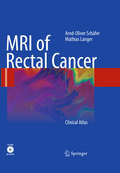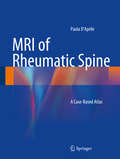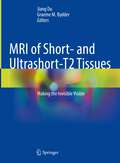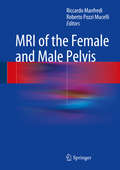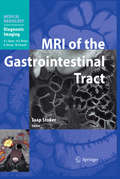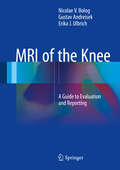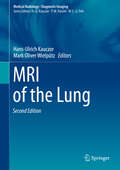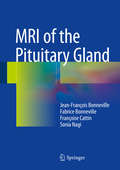- Table View
- List View
MRI at a Glance (At a Glance)
by Catherine WestbrookMRI at a Glance provides concise, easily accessible information on MRI physics and is an invaluable revision aid. All topics are included from magnetism to safety, K space to pulse sequences, image contrast to artefacts. The second edition has been fully revised and updated with brand new information on data acquisition and pulse sequences. The book is now in full colour throughout and follows the familiar, easy-to-use at a Glance format with each topic presented as a double-page spread with key facts accompanied by clear diagrams encapsulating essential knowledge.
MRI at a Glance (At a Glance)
by Catherine WestbrookMRI at a Glance provides concise, easily accessible information on MRI physics and is an invaluable revision aid. All topics are included from magnetism to safety, K space to pulse sequences, image contrast to artefacts. The second edition has been fully revised and updated with brand new information on data acquisition and pulse sequences. The book is now in full colour throughout and follows the familiar, easy-to-use at a Glance format with each topic presented as a double-page spread with key facts accompanied by clear diagrams encapsulating essential knowledge.
MRI: The Basics (The\basics Ser.)
by Ray H. Hashemi Christopher J. Lisanti William BradleyConcise, readable, and engaging, MRI: The Basics, 4th Edition, offers an excellent introduction to the physics behind MR imaging. Clinically relevant coverage includes everything from basic principles and key math concepts to more advanced topics, including the latest MR techniques and optimum image creation. Hundreds of high-quality illustrations, board-style questions and answers, legible equations, and instructive diagrams take you from the basics of MR physics through current applications.
MRI Contrast Agents
by Sophie Laurent Céline Henoumont Dimitri Stanicki Sébastien Boutry Estelle Lipani Sarah Belaid Robert N. Muller Luce Vander ElstThis book describes the multiple aspects of (i) preparation of the magnetic core, (ii) the stabilization with different coatings, (iii) the physico-chemical characterization and (iv) the vectorization to obtain specific nanosystems. Several bio-applications are also presented in this book. In the early days of Magnetic Resonance Imaging (MRI), paramagnetic ions were proposed as contrast agents to enhance the diagnostic quality of MR images. Since then, academic and industrial efforts have been devoted to the development of new and more efficient molecular, supramolecular and nanoparticular systems. Old concepts and theories, like paramagnetic relaxation, were revisited and exploited, leading to new scientific tracks. With their high relaxivity payload, the superparamagnetic nanoparticles are very appealing in the context of molecular imaging but challenges are still numerous: absence of toxicity, specificity, ability to cross the biological barriers, etc.
MRI for Radiotherapy: Planning, Delivery, and Response Assessment
by Gary Liney Uulke van der HeideThis book provides, for the first time, a unified approach to the application of MRI in radiotherapy that incorporates both a physics and a clinical perspective. Readers will find detailed information and guidance on the role of MRI in all aspects of treatment, from dose planning, with or without CT, through to response assessment. Extensive coverage is devoted to the latest technological developments and emerging options. These include hybrid MRI treatment systems, such as MRI-Linac and proton-guided systems, which are ushering in an era of real-time MRI guidance. The past decade has witnessed an unprecedented rise in the use of MRI in the radiation treatment of cancer. The development of highly conformal dose delivery techniques has led to a growing need to harness advanced imaging for patient treatment. With its flexible soft tissue contrast and ability to acquire functional information, MRI offers advantages at all stages of treatment. In documenting the state of the art in the field, this book will be of value to a wide range of professionals. The authors are international experts drawn from the scientific committee of the 2017 MR in RT symposium and the faculty of the ESTRO teaching course on imaging for physicists.
MRI From Picture to Proton
by Donald W. Mcrobbie Elizabeth A. Moore Martin J. Graves Martin R. PrinceMRI from Picture to Proton presents the basics of MR practice and theory in a unique way: backwards! The subject is approached just as a new MR practitioner would encounter MRI: starting from the images, equipment and scanning protocols, rather than pages of physics theory. The reader is brought face-to-face with issues pertinent to practice immediately, filling in the theoretical background as their experience of scanning grows. Key ideas are introduced in an intuitive manner which is faithful to the underlying physics but avoids the need for difficult or distracting mathematics. Additional explanations for the more technically inquisitive are given in optional secondary text boxes. The new edition is fully up-dated to reflect the most recent advances, and includes a new chapter on parallel imaging. Informal in style and informed in content, written by recognized effective communicators of MR, this is an essential text for the student of MR.
MRI from Picture to Proton
by Mcrobbie Donald W. Moore Elizabeth A. Graves Martin J.MRI from Picture to Proton presents the basics of MR practice and theory in a unique way: backwards! The subject is approached just as a new MR practitioner would encounter MRI: starting from the images, equipment and scanning protocols, rather than pages of physics theory. The reader is brought face-to-face with issues pertinent to practice immediately, filling in the theoretical background as their experience of scanning grows. Key ideas are introduced in an intuitive manner which is faithful to the underlying physics but avoids the need for difficult or distracting mathematics. Additional explanations for the more technically inquisitive are given in optional secondary text boxes. The new edition is fully up-dated to reflect the most recent advances, and includes a new chapter on parallel imaging. Informal in style and informed in content, written by recognized effective communicators of MR, this is an essential text for the student of MR.
MRI from A to Z
by Gary LineyThis second edition of Gary Liney's MRI from A-Z, much expanded from the first edition, is both a reflection of and an apt companion for the dramatic growth of the field of MRI. The MRI-trainee to the most seasoned practitioner in MRI will find this A-Z of the field, with 1,300 entries and 100 illustrations, an indispensable reference tool. Providing the reader with concise, clear and eloquent definitions of MRI terminology, this book is both highly practical and a pleasure to read.
MRI Handbook
by Muhammed Elmaoğlu Azim ÇelikMRI Handbook presents a concise review of the physical principles underlying magnetic resonance imaging (MRI), explaining MR physics, patient positioning, and protocols in an easy-to-read format. The first five chapters of the book introduce the reader to the basics of MR imaging, including the relaxation concept, MR pulse sequences, and MR imaging parameters and options. The second part of the book (chapters 6-11) uses extensive illustrations, images, and protocol tables to explain tips and tricks to achieve optimal MR image quality while ensuring patient safety. Individual chapters are devoted to each major anatomic region, including the central nervous, musculoskeletal, and cardiovascular systems. By using annotated MR images and examples of patient positions used during scanning correlated with sample protocols and parameters, MRI Handbook is a practical resource for imaging professionals to use in the course of their daily practice as well as for students to learn the basic concepts of MR imaging.
MRI in Epilepsy
by Horst UrbachMRI can play an important role in identifying and localizing epileptogenic foci. This book aims to provide the clinical and imaging information required in order to decide whether an MRI scan is appropriate and whether it is likely to be sufficient to detect a lesion. The first part of the book presents background information on epilepsy patients and explains how to perform an MRI examination. Detailed attention is paid to functional MRI and post-processing, and the examination of subcategories of patients is also discussed. The second part of the book then documents the MRI findings obtained in the full range of epileptogenic lesions with the aid of high-quality images. Throughout, emphasis is placed on guiding the reader in the correct interpretation of the imaging findings. Both radiologists and referring physicians will find this book to be an indispensable guide to the optimal use of MRI in epilepsy.
MRI in Practice
by Carolyn Kaut Roth John Talbot Catherine WestbrookSince the first edition was published in 1993, MRI in Practice has become the standard text for radiographers, technologists, radiology residents, radiologists and even sales representatives on the subject of Magnetic Resonance Imaging (MRI). This text is essential reading on undergraduate and postgraduate MRI courses. Furthermore MRI in Practice has come to be known as the number one reference book and study guide in the areas of MR instrumentation, principles, pulse sequences, image acquisition, and imaging parameters for the advanced level examination for MRI offered by the American Registry for Radiologic Technologists (ARRT) in the USA.The book explains in clear terms the theory that underpins magnetic resonance so that the capabilities and operation of MRI systems can be fully appreciated and maximised. This fourth edition captures recent advances, and coverage includes: parallel imaging techniques and new sequences such as balanced gradient echo.Building on the success of the first three editions, the fourth edition has been fully revised and updated. The book now comes with a companion website at www.wiley.com/go/mriinpractice which hosts animated versions of a selection of illustrations in the book that are used on the MRI in Practice Course. These animations and accompanying text are aimed at helping the reader's comprehension of some of the more difficult concepts. The website also hosts over 200 interactive self-assessment exercises to help the reader test their understanding.MRI in Practice features:Full color illustrationsLogical presentation of the theory and applications of MRIA new page designA companion website at www.wiley.com/go/mriinpractice featuring interactive multiple choice questions, short answer questions PLUS animations of more complex concepts from the bookFor more information on the MRI in Practice Course and other learning resources by Westbrook and Talbot, please visit www.mrieducation.com
MRI in Practice
by John Talbot Catherine WestbrookMRI in Practice continues to be the number one reference book and study guide for the registry review examination for MRI offered by the American Registry for Radiologic Technologists (ARRT). This latest edition offers in-depth chapters covering all core areas, including: basic principles, image weighting and contrast, spin and gradient echo pulse sequences, spatial encoding, k-space, protocol optimization, artefacts, instrumentation, and MRI safety. The leading MRI reference book and study guide. Now with a greater focus on the physics behind MRI. Offers, for the first time, equations and their explanations and scan tips. Brand new chapters on MRI equipment, vascular imaging and safety. Presented in full color, with additional illustrations and high-quality MRI images to aid understanding. Includes refined, updated and expanded content throughout, along with more learning tips and practical applications. Features a new glossary. MRI in Practice is an important text for radiographers, technologists, radiology residents, radiologists, and other students and professionals working within imaging, including medical physicists and nurses.
MRI-Negative Epilepsy
by Elson L. So Philippe RyvlinDrug-resistant epilepsy with negative MRI is frequently seen in patients considered for epilepsy surgery; however, clinical evaluation and surgical treatment is very complex and challenging. Advanced imaging techniques are needed to detect the location of the epileptogenic zone. In most cases, intracranial EEG recording is required to delineate the region of seizure onset - this carries some risks of major complications. Moreover, the borders between the recorded seizure onset and the location of important brain functions are often indistinct in MRI-negative epilepsy. Overall, the outcome of MRI-negative surgery is less favorable than that of MRI-positive surgery, but it can significantly improve with optimal management. Each chapter critically appraises the role and value of specific diagnostic and treatment techniques to address the challenges of MRI-negative epilepsy surgery. Authors critique evidence and share their expertise on the diagnostic options and surgical approaches that make epilepsy surgery possible and worthwhile in patients with this condition.
MRI of Cardiovascular Malformations
by Bruno KastlerMRI is a non-invasive and non-ionizing imaging modality that is perfectly suited for the diagnosis and follow-up of both pediatric and adult congenital heart disease. It provides a large field of view and has the unique ability to depict complex cardiac and vascular anatomy and to measure cardiac function and flow within one examination. MRI is the ideal complement to echocardiography whenever the information provided by the latter is limited. This book has been conceived as a self-teaching manual that will assist qualified radiologists, cardiologists, and pediatricians, as well as those in training. It is richly illustrated with numerous images and drawings that cover all usual and most unusual anomalies. The principal author, Professor Bruno Kastler, is head of radiology at Besançon University Hospital, France and is board certified in both radiology and cardiology.
MRI of Degenerative Disease of the Spine
by Paola D'AprileThis richly illustrated case-based atlas thoroughly depicts the role of MR imaging in the assessment of patients presenting with pain due to degenerative disease of the spine and will serve as an excellent guide to differential diagnosis. Importantly, generic radicular compression is the main reason for the painful symptomatology in only a limited number of cases, and this book illustrates and emphasizes how various anatomic elements of the spine can be responsible. The imaging features of a range of disorders involving both the anterior and posterior elements of the spine are described, including active inflammatory osteochondrosis, atypical herniated discs, facet joint disorders, spondylolysis, and degenerative-inflammatory changes of the spinal ligaments and posterior perispinal muscles. Each example is supported by clinical data, and a series of unusual cases are also presented. MR study protocols include T2-weighted sequences with fat saturation and contrast-enhanced T1-weighted sequences with fat saturation to allow better visualization or highlighting of various inflammatory changes in the spine. Radiologists, neuroradiologists, neurosurgeons, orthopedists, and rehabilitation physicians will all find this atlas a valuable asset in their practice.
MRI of Degenerative Disease of the Spine: A Case-Based Atlas
by Paola D'Aprile Alfredo TarantinoThis is the second edition of an acclaimed, richly illustrated and comprehensive case-based atlas focusing on MRI of degenerative changes in the osteoarticular structures of the spine. Spinal degenerative disease is highly prevalent in the general population and its incidence increases with age. At the same time, degenerative spinal conditions are one of the most common causes of pain.The book presents a comprehensive overview of the MR findings observed in degenerative disease of spinal joints, ligaments and paravertebral muscles, and offers guidance on selecting the appropriate imaging protocol, which is critical in detecting the potentially very subtle changes. The MR study protocols presented include T2-weighted sequences with fat saturation and contrast-enhanced T1-weighted sequences with fat saturation, since these sequences permit better visualization of inflammatory changes of both anterior and posterior elements of the spine.This richly illustrated second edition highlights the inflammatory component of the degenerative pathology of the spine, which in most cases is responsible for the painful symptomatology. It also discusses in detail the use of contrast medium in MRI of spinal degenerative disease. The “case-based” structure of the atlas allows easy but effective consultation by radiologists, neuroradiologists, rheumatologists, orthopedists and physiatrists, as well as students.
MRI of Gynaecological Diseases: Illustrations and Cases
by Guofu ZhangThis book systematically covers MRI imaging findings of a spectrum of gynaecological diseases, including ovarian cysts, uterine fibroids, cervical cancer, and endometrial cancer, etc. All chapters are arranged in the same format: simply clinical history is firstly presented in order to help readers mimic the real clinical scenario, and then untypical features in many common diseases and typical features in many uncommon diseases are interpreted. In the end of each chapter, tips in differential diagnosis were summarized by analysing a class of cases with similar imaging performance. All cases in the book have the detailed pathological results, and the pathological specimens are also shown in some cases. It will be an ideal reference for physicians involved in the diagnosis and treatment of gynaecological diseases.
MRI of Rectal Cancer
by Mathias Langer Arnd-Oliver SchäferToday magnetic resonance imaging (MRI) of rectal cancer is one of the most interesting topics in radiology. Over the last decade technical refinements have strengthened the role of MRI as a first-line diagnostic strategy for accurate staging of rectal cancer. MRI is perfectly suited to predict tumor-free circumferential resection margins. Additionally, high accuracies have been reported for the T and N stages, which is comparable to transrectal ultrasound (TRUS). Novel approaches to moving table MRI serve as a platform for thoracic, abdominal and pelvic staging of rectal cancer patients within one examination. The broad spectrum of high-quality illustrations and the contribution of clinical experts provide substantial insight into the sophisticated field of rectal cancer management.
MRI of Rheumatic Spine
by Paola D'AprileThis richly illustrated and comprehensive case-based atlas documents the MR findings observed in spondyloarthritis and offers guidance on selection of the appropriate imaging protocol, which is critical in detecting the potentially very subtle changes. The presented MR study protocols include T2-weighted sequences with fat saturation and contrast-enhanced T1-weighted sequences with fat saturation, these being sequences which permit better visualization of inflammatory changes of both anterior and posterior elements of the spine. Cases of spondylitis, discitis, osteoarthritis and sacroiliitis are described and concise information is provided on the clinical history of the rheumatic diseases. The inclusion of a large number of high-resolution images ensures that the atlas will serve as a guide to differentiation between potentially confounding diseases and an aid to early diagnosis, which has become essential with the advent of new treatments in the field of spondyloarthritis (TNF inhibitors). In addition to radiologists, neuroradiologists, rheumatologists, orthopedists and physiatrists will greatly benefit from the contents of this volume and its thorough presentation of the rheumatic diseases.
MRI of Short and Ultrashort-T_2 Tissues: Making the Invisible Visible
by Jiang Du Graeme M. BydderThis book comprehensively covers ultrashort echo time (UTE), zero echo time (ZTE), and other magnetic resonance imaging (MRI) acquisition techniques for imaging of short and ultrashort-T2 tissues. MRI uses a large magnet and radio waves to generate images of tissues in the body. The MRI signal is characterized by two time constants, spin-lattice relaxation time (T1) which describes how fast the longitudinal magnetization recovers to its initial value after tipping to the transverse plane, and spin-spin relaxation time (T2) which describes how fast the transverse magnetization decays. Conventional MRI techniques have been developed to image and quantify tissues with relatively long T2s. However, the body also contains many tissues and tissue components such as cortical bone, menisci, ligaments, tendons, the osteochondral junction, calcified tissues, lung parenchyma, iron containing tissues, and myelin, which have short or ultrashort-T2s. These tissues are “invisible” with conventional MRI, and their MR and tissue properties are not measurable. UTE and ZTE type sequences resolve these challenges and make these tissues visible and quantifiable.This book first introduces the basic physics of conventional MRI as well as UTE and ZTE type MRI, including radiofrequency excitation, data acquisition, and image reconstruction. A series of contrast mechanisms are then introduced and these provide high resolution, high contrast imaging of short and ultrashort-T2 tissues. A series of quantitative UTE imaging techniques are described for measurement of MR tissue properties (proton density, T1, T2, T2*, T1p,magnetization transfer, susceptibility, perfusion and diffusion). Finally, clinical applications in the musculoskeletal, neurological, pulmonary and cardiovascular systems are described.This is an ideal guide for physicists and radiologists interested in learning more about the use of UTE and ZTE type techniques for MRI of short and ultrashort-T2 tissues.
MRI of the Female and Male Pelvis
by Riccardo Manfredi Roberto Pozzi MucelliBased on the experience of two Italian referral centers, the book depicts the characteristic findings obtained when using MR imaging to study the male and female pelvis including the obstetric applications. Each chapter provides a comprehensive account of the use of the imaging technique of examination, including the most recent advances in MR imaging, the anatomy and MR possibilities in the identification, characterization and staging of the different pelvic diseases highlighting its diagnostic possibilities. The advances in fetal MRI, representing the cutting edge of pelvic MR imaging, will also be depicted. The text is complemented by numerous illustrations, as well as clinical cases that make this a very practice-oriented work, presenting the role of diagnostic imaging in every-day clinical activity. The volume will prove an invaluable guide for both residents and professionals with core interest in gynecology, obstetrics and urology.
MRI of the Gastrointestinal Tract
by Jaap StokerMRI has become an important tool in the management of patients with diseases of the gastrointestinal tract, such as rectal cancer and inflammatory bowel diseases. This book, written by distinguished experts in the field, discusses in detail the technical, practical, and clinical aspects of MRI of the gastrointestinal tract. The chapters on technique encompass the most recent developments and address such topics as contrast media, high field strength MRI, and perfusion MRI. Subsequently, individual chapters are devoted to the clinical applications of MRI in the different parts of the gastrointestinal tract. Both established applications and new frontiers are considered, with the aid of numerous high-quality illustrations. By combining chapters dedicated to technical aspects and clinically oriented chapters, this book will prove very instructive for the novice while simultaneously offering experienced practitioners further insights into the value of MRI of the gastrointestinal tract.
MRI of the Knee
by Nicolae V. Bolog Gustav Andreisek Erika J. UlbrichThis book is divided into chapters that cover MRI of all structures of the knee joint in the order that is usually used in practice - cruciate ligaments, collateral ligaments, menisci, cartilage, subchondral bone, patella, synovia, muscles and tendons, arteries, veins and bones With the aid of numerous images, each chapter provides comprehensive descriptions of the anatomy, the normal MR appearance, pathological MR findings, and postoperative MRI appearance. A text box at the end of each chapter clearly describes how the MRI report should be compiled and identifies what should be included when reporting on specific lesions. The book will be an ideal guide for radiologists and will also be relevant for orthopaedic surgeons, rheumatologists, and physiotherapists.
MRI of the Lung (Medical Radiology)
by Hans-Ulrich Kauczor Mark Oliver WielpützThis book provides a comprehensive overview of how to use MRI for the imaging of lung disease. Special emphasis is placed on routine applications and the clinical impact of MRI in each setting. In addition, current technological developments are reviewed and information presented on dedicated applications of MRI in preclinical and translational research, clinical trials, and specialized institutions.During the past two decades, significant advances in the technology have enabled MRI to enter and mature in the clinical arena of chest imaging. Standard protocols are now readily available on MR scanners, and MRI is recommended as the first- or second-line imaging modality for a variety of lung diseases, not limited to cystic fibrosis, pulmonary hypertension, and lung cancer. The benefits and added value of MRI originate from its ability to both visualize lung structure and provide information on different aspects of lung function, such as perfusion, respiratory motion, ventilation, and gas exchange. On this basis, novel quantitative surrogates for lung function and therapy control (imaging biomarkers) are generated. The second edition of MRI of the Lung has been fully updated to take account of recent advances. It is written by an internationally balanced team of renowned authors representing all major groups in the field.
MRI of the Pituitary Gland
by Jean-François Bonneville Fabrice Bonneville Françoise Cattin Sonia NagiThis clinically oriented book will familiarize the reader with all aspects of the diagnosis of tumors and other disorders of the pituitary gland by means of magnetic resonance imaging (MRI). The coverage includes acromegaly, Cushing's disease, Rathke cleft cysts, prolactinomas, incidentalomas, nonsecreting adenomas, other lesions of the sellar area, hypophysitis, and central diabetes insipidus. Normal radiologic anatomy and the numerous normal variants are described, and guidance is also provided on difficulties, artifacts, and other pitfalls. The book combines concise text and high-quality images with a question and answer format geared toward the needs of the practitioner. MRI is today considered the cornerstone in the diagnosis of diseases of the hypophyseal-hypothalamic region but the relatively small size of the pituitary gland, its deep location, the many normal anatomic variants, and the often tiny size of lesions can hinder precise evaluation of the anatomic structures and particularly the pituitary gland itself. Radiologists and endocrinologists will find MRI of the Pituitary Gland to be full of helpful information on this essential examination, and the book will also be of interest to internists and neurosurgeons.
